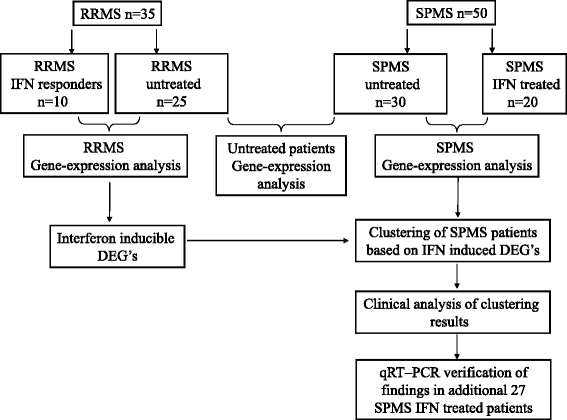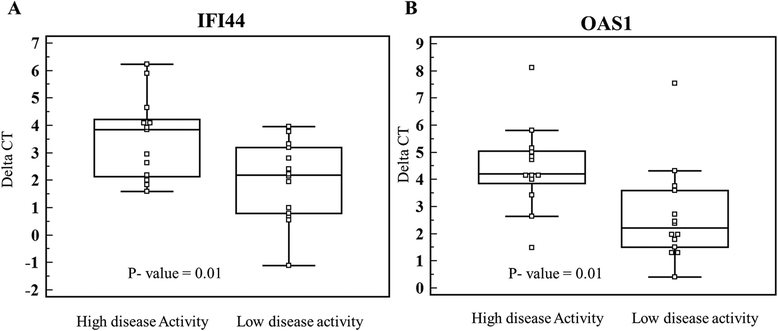Transcriptional response to interferon beta-1a treatment in patients with secondary progressive multiple sclerosis
- PMID: 26589141
- PMCID: PMC4654830
- DOI: 10.1186/s12883-015-0495-x
Transcriptional response to interferon beta-1a treatment in patients with secondary progressive multiple sclerosis
Abstract
Background: Interferon (IFN) beta-1a is an approved treatment for relapsing remitting multiple sclerosis (RRMS) and has been examined for use in secondary progressive multiple sclerosis (SPMS). However, no information regarding blood transcriptional changes induced by IFN treatment in SPMS patients is available. Our aim was to identify a subgroup of SPMS patients presenting a gene expression signature similar to that of RRMS patients who are clinical responders to IFN treatment.
Methods: SPMS patients (n = 50, 20 IFN treated and 30 untreated) were classified using unsupervised hierarchical clustering according to IFN inducible gene expression profile identified in RRMS clinical responders to treatment. IFN inducible gene expression profile was determined by finding differentially expressed genes (DEGs) between IFN treated (n = 10) and untreated (n = 25) RRMS patients. Validation was performed on an additional independent group of 27 SPMS IFN treated patients by qRT-PCR.
Results: One hundred and four DEGs, enriched by IFN signaling pathway (p = 7.4E-08), were identified in IFN treated RRMS patients. Classification of SPMS patients based on these DEGs yielded two patient groups: (1) IFN transcriptional responders (n = 12, 60% of SPMS treated patients) showing gene-expression profile similar to IFN treated RRMS patients; (2) IFN transcriptional non-responders (n = 8) showing expression profile similar to untreated patients. IFN transcriptional responders were characterized by a more active disease, as defined by higher EDSS progression and annual relapse rate.
Conclusion: Within the IFN treated SPMS population, 60% of patients have a transcriptional response to IFN which is similar to that of RRMS patients who are IFN responders to treatment.
Figures




Similar articles
-
Cost-effectiveness analysis of ocrelizumab versus subcutaneous interferon beta-1a for the treatment of relapsing multiple sclerosis.J Med Econ. 2017 Oct;20(10):1056-1065. doi: 10.1080/13696998.2017.1355310. Epub 2017 Jul 31. J Med Econ. 2017. PMID: 28703659
-
Clinical and MRI efficacy of sc IFN β-1a tiw in patients with relapsing MS appearing to transition to secondary progressive MS: post hoc analyses of PRISMS and SPECTRIMS.J Neurol. 2020 Jan;267(1):64-75. doi: 10.1007/s00415-019-09532-5. Epub 2019 Sep 26. J Neurol. 2020. PMID: 31559532 Free PMC article. Clinical Trial.
-
Distinct chemokine receptor and cytokine expression profile in secondary progressive MS.Neurology. 2001 Oct 23;57(8):1371-6. doi: 10.1212/wnl.57.8.1371. Neurology. 2001. PMID: 11673573
-
Effect of drugs in secondary disease progression in patients with multiple sclerosis.Mult Scler. 2004 Jun;10 Suppl 1:S46-54; discussion S54-5. doi: 10.1191/1352458504ms1030oa. Mult Scler. 2004. PMID: 15218809 Review.
-
Interferon-beta-1b: a review of its use in relapsing-remitting and secondary progressive multiple sclerosis.CNS Drugs. 2004;18(8):521-46. doi: 10.2165/00023210-200418080-00004. CNS Drugs. 2004. PMID: 15182221 Review.
Cited by
-
ADAR Expression and Single Nucleotide Variants in Multiple Sclerosis Patients Affect the Response to Interferon Beta Therapy.Glob Med Genet. 2023 Jul 10;10(3):164-171. doi: 10.1055/s-0043-1771001. eCollection 2023 Sep. Glob Med Genet. 2023. PMID: 37501759 Free PMC article.
-
Blood metabolomic and transcriptomic signatures stratify patient subgroups in multiple sclerosis according to disease severity.iScience. 2024 Feb 15;27(3):109225. doi: 10.1016/j.isci.2024.109225. eCollection 2024 Mar 15. iScience. 2024. PMID: 38433900 Free PMC article.
-
Sunlight exposure exerts immunomodulatory effects to reduce multiple sclerosis severity.Proc Natl Acad Sci U S A. 2021 Jan 5;118(1):e2018457118. doi: 10.1073/pnas.2018457118. Proc Natl Acad Sci U S A. 2021. PMID: 33376202 Free PMC article.
-
Immunophenotype and Transcriptome Profile of Patients With Multiple Sclerosis Treated With Fingolimod: Setting Up a Model for Prediction of Response in a 2-Year Translational Study.Front Immunol. 2018 Jul 25;9:1693. doi: 10.3389/fimmu.2018.01693. eCollection 2018. Front Immunol. 2018. PMID: 30090102 Free PMC article.
-
Meta-Analysis of Differential Connectivity in Gene Co-Expression Networks in Multiple Sclerosis.Int J Mol Sci. 2016 Jun 15;17(6):936. doi: 10.3390/ijms17060936. Int J Mol Sci. 2016. PMID: 27314336 Free PMC article.
References
Publication types
MeSH terms
Substances
LinkOut - more resources
Full Text Sources
Other Literature Sources
Molecular Biology Databases

